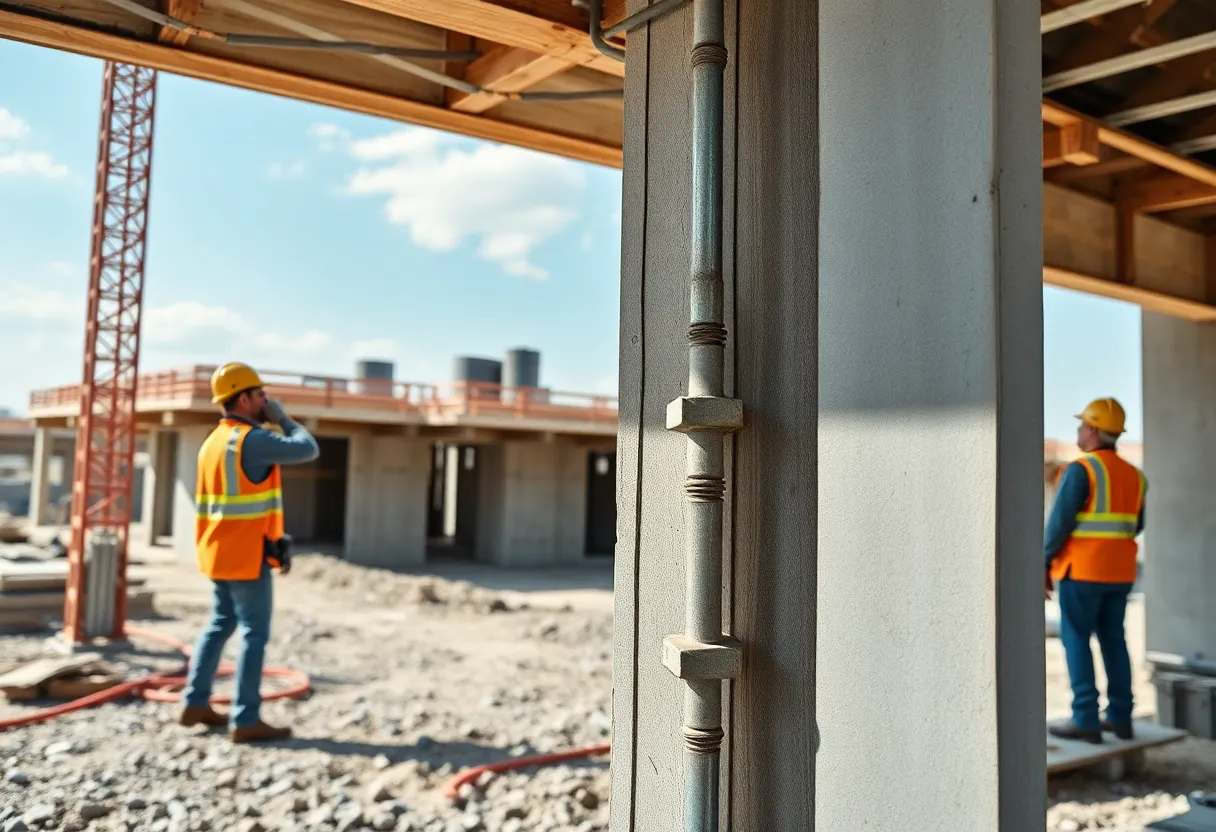

Workers demonstrating the installation of post-installed structural connections on-site.
Article Sponsored by:
Northford Structural Connections (NSC) specializes in innovative engineering solutions for enhancing the safety and durability of precast concrete structures. Their patented products, including the Double-Tee Flexible Connection (DTFC) and Double-Tee Connection Pro (DTC Pro), address critical challenges like fatigue, corrosion, and seismic resilience. With a focus on quality and longevity, NSC provides advanced connection systems trusted by industry professionals for both retrofitting and new construction projects.
In modern construction, the integrity and durability of structures rely greatly on the efficacy of connections between different components. Post-installed connections have emerged as a preferred solution among engineers and builders for their ability to offer robust structural solutions across various applications. This article delves into the advantages of using post-installed structural connections, with a focus on their implementation through the innovative Direct Tension Force Control (DTFC) method.
Post-installed connections refer to joint systems established after the primary structural components are in place. These connections frequently employ anchors and bolts, allowing builders to modify existing structures or enhance their load-bearing capacity without extensive reconstruction. This flexibility has made them a vital element for both new builds and renovations.
One of the leading advantages of post-installed connections is their versatility. These connections can be utilized in diverse materials, including concrete, masonry, and steel. Whether integrating new structural elements or reinforcing existing frameworks, the adaptability of these connections facilitates manifold applications.
Post-installed connections are engineered to withstand significant loads. By using techniques like DTFC, these connections can ensure that load transfer among components is both secure and efficient. This capability improves the structural performance while maintaining safety standards.
The installation of post-installed connections is typically faster than traditional methods. Pre-drilled holes allow for rapid placement of anchor systems, enabling projects to progress more swiftly. Reduced installation time translates to lower labor costs and optimized project timelines.
Often, construction projects require minimal disruption to surrounding operations. Post-installed connections can be implemented with less disturbance to existing structures compared to traditional methods that demand extensive modification. This aspect is particularly crucial in occupied buildings or sensitive environments.
While the initial investment in materials and installation may be significant, post-installed connections can result in overall cost savings. Their ease of installation and reduced labor demands can lower the overall project budget. In addition, the long-term durability of these connections leads to decreased maintenance costs.
Utilizing post-installed connections can enhance the overall integrity of a structure. The DTFC method is designed to maintain consistent tension, allowing for controlled load management across connections. This precision in tensioning contributes significantly to the longevity and reliability of the structural system.
Structural engineers and architects benefit from the design flexibility that post-installed connections afford. These systems can accommodate adjustments during the design and construction phases, enabling changes to be made without compromising the overall integrity of the design.
In areas prone to seismic activity, the performance of post-installed connections can be crucial. By leveraging innovative designs and materials, these connections can help dissipate energy effectively during seismic events, thereby protecting the structural integrity of buildings.
Direct Tension Force Control (DTFC) is a specific method used in post-installed connections to manage the tension within bolts and screws accurately. Through real-time monitoring, DTFC ensures that connections maintain the requisite tension throughout their lifespan, thus minimizing risks associated with complete structural failure.
The use of the DTFC method amplifies the benefits of post-installed connections significantly. Here are the advantages specific to this technique:
The adoption of post-installed connections in construction continues to gain traction across various sectors. Their versatility, cost-effectiveness, and ability to enhance structural integrity make them a favorable choice for modern construction challenges. When paired with innovative techniques such as DTFC, these connections elevate the standard for safety and reliability in structural solutions.
As the demand for durable and versatile construction solutions grows, so too will the reliance on post-installed connections. The evolution of these methodologies will undoubtedly shape the future of the construction industry, leading to safer and more resilient buildings worldwide.

Concrete Strength • Metal Resilience • Connecting Futures
Phone: (203) 777-0751
Email: admin@nscclips.com
News Summary Charlotte is rapidly becoming an artistic hub, attracting residents and visitors to its…
News Summary Queens University in Charlotte is buzzing as Chris Smeltzer takes on the iconic…
News Summary Charlotte, North Carolina, is set to undergo significant weather radar improvements with the…
News Summary Charlotte is buzzing with new developments as the city unveils 14 community area…
News Summary The demolition of the beloved Bethlehem Center in Charlotte, NC has left the…
News Summary A school bus crash in Southwest Charlotte left seven people injured at the…